WHARFEDALE LINTON Review: Back to the Future
David Price spends some time with a re-imagined iconic standmount that’s anything but a seventies throwback. Read our WHARFEDALE LINTON Review.
Plenty of audiophiles have a fondness for retro design, but many would agree that it’s modern technology and fresh thinking that shapes our world. This is true up to a point, but plenty of hi-fi companies such as JBL and Technics, for example, are re-examining past ideas, too.

ORIGIN UK/China
TYPE 3-way stand mount loudspeaker
WEIGHT 18.4kg
DIMENSIONS (WxHxD) 300 x 565 x 330mm
FEATURES
• 1x 25mm textile dome tweeter
• 1x 135mm midrange driver
• 1x200mm bass driver
• Quoted sensitivity: 90dB/1W/1m
DISTRIBUTOR IAG Ltd.
TELEPHONE 01480 447700
WEBSITE wharfedale.co.uk
Adding to its Heritage collection – which re-engineers former models using contemporary techniques and materials – Wharfedale’s new Linton does just this; being a large, wide-baffle stand mount speaker, it’s very much in the mold of big seventies designs and totally out of-fashion compared to with the small footprint ‘tower’ floor standers of today. Yet designer Peter Comeau tells me: “This is not a throwback to days of old, far from it. This is simply good engineering practice. The broader baffle and larger-than-normal bass and midrange units not only elevate sensitivity but also are aligned to a baffle step that is lower and broader in frequency than modern, slimline systems.”
A large-scale, gutsy presentation but with decent subtlety and smoothness
In other words, by not following fashion, he can do the right thing as far as the physics of speaker design is concerned.
The trouble is that the vagaries of marketing are also critical to how modern loudspeakers are designed. Comeau notes that the company’s 85th anniversary has given him the chance to do something more than slightly different. “As we found when we launched the Denton 80th Anniversary (and then Denton 85), there’s a strong customer base for this style of speaker. Retro, maybe, but more likely a response to good-quality furniture appearance allied to the full-bodied sound of speakers designed from the fifties to eighties.”
The name Linton will ring like a bell to audiophiles of a certain age – myself included, as my father had a pair of 3XPs in the seventies. It was the poor man’s high-end loudspeaker, a true three-way with a real wood cabinet and a warm, musical sound. The new one is far larger, however, and instead of paper and polymer for its bass and mid drivers, it uses woven Kevlar in 200mm and 135mm sizes, respectively. Also, the old soft-dome tweeter is now a 25mm fabric dome with a metal grille over it. Crossover frequencies are 630Hz and 2.4kHz.
The cabinet is reflex-loaded via twin rear-mounted ports, unlike the original’s infinite baffle design, and this confers dramatically better sensitivity (90dB up from 86dB) and bass extension (35Hz down from 60Hz). “It uses a sandwich of high-density chipboard with MDF skins that scatters panel resonance more effectively than the almost ubiquitous modern use of MDF alone,” he adds. “Finally, the crossover has been designed using computer software together with hundreds of hours of listening tests and refinement.”

So big and heavy is this 18.4kg speaker, which makes the original feel like a toy – and the real walnut or mahogany veneered cabinet is done to a much higher standard than yore. The grilles are removable, but the speaker sounds better with them in place as they’re specially designed to aid the dispersion of the tweeter. Interestingly, the speakers are ‘handed’ and should be positioned with the tweeters inwards. I can’t overstate how much better-made everything feels than its ancestor, so the price per pair is all the more surprising. There’s also an optional pair of dedicated stands (not shown) per pair, but if you buy both together, the total cost is just £. Together, they look very good, but I’m not totally convinced by the stands’ wood inserts – which look like a bit of an afterthought.
INSIGHT
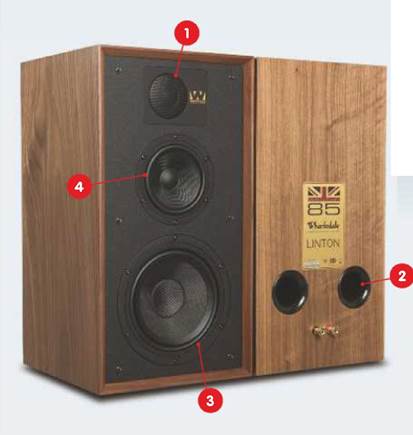
- 25mm textile dome tweeter
- Reflex-loaded bass ports
- 200mm bass driver
- 135mm midrange driver
Sound quality
The problem with nostalgia is that it isn’t what it used to be, as the old gag goes. Yet actually, this speaker sounds strangely modern – far more than you would expect by looking at it – while avoiding the pitfalls of both classic and new designs. The Linton sure is quite different from your average modern ‘tower’ loudspeaker, with a sense of physicality and heft to the lower registers, which is really something special. I start off with ELO’s Mr Blue Sky – a classic late-seventies slice of pop – and this speaker belts it out with relish. There’s an uncanny feeling of lots of air moving around the room, yet despite this, it still sounds really relaxed, showing tremendous grace under pressure and never breaking into a sweat.
Thanks to this relaxed, insouciant character, the music saunters along happily, and everything sounds fun – whatever musical genre you choose.
For example, Rush’s Subdivisions is an early eighties digital recording that’s both dense and compressed, yet the Linton makes it seriously special. As the song powers along, it separates out the individual elements of the mix with surprising ease. I can enjoy all the musicians playing together really tightly, hearing them coming together to make one cohesive whole. It also seems uncannily easy to peer into the mix, separating elements with aplomb.
There’s a sense of physicality to the lower registers that’s really special
Although it gets the thumbs up for its ease, scale, and musicality, the Wharfedale isn’t without criticism. Listen hard, and you can hear a slight opacity to its upper ranges. This is most obvious with shiny, super-clean recordings like Scritti Politti’s Perfect Way. This eighties classic shows the tweeter’s slight lack of delicacy, although it never sounds coarse. At the same time, it’s clear that the mid-band softens things out a bit, lending its own – admittedly subtle – sonic fingerprint to the proceedings.
For example, it is unable to resolve the chiming sound of the track’s early digital synthesizer in all its glory and brings just a touch of nasality to vocals in absolute terms. Given its very modest price, this is not a criticism but merely a remark. Yet the great thing about the Linton is it covers its tracks so well. Although not the greatest speaker ever made, you never find yourself dwelling on this point. Instead, whatever I play gets into the musical groove.
Provided that you spend time properly toeing in the speaker to the best angle for your listening position – and it can be quite a fine balance – you’ll doubtless be impressed by the stereo imaging. It doesn’t quite have the pinpoint precision of some rivals with coaxial tweeter/midrange drivers, but it’s still pretty good and gives the lie to the claim that wide baffle speakers don’t image well. Every recording I play sounds surprisingly large and expansive. Haitink’s superb reading of Vaughan Williams’ Symphony No.2 sounds wonderfully atmospheric with a great sense of the recorded acoustic, for example. Depth perspective is a real standout strength for this speaker, too.
Another pleasing facet of the Linton is its dynamic headroom; it’s able to track musical crescendos really well for a loudspeaker at this price. This, allied with its more than decent timing, makes for a lively, vibrant rendition of anything you care to play through it. Rather like the re-imagined or re-released JBL and Klipsch speakers I’ve also heard recently, it isn’t especially neutral – and nor does it set out to be. Yet it’s undoubtedly unalloyed fun offering up a large-scale, bold, and gutsy presentation, but still with a decent amount of subtlety and smoothness. This stand-mount has an excellent table.

It might look a little retro, but the performance is utterly modern manners, so to speak, yet is never a boring listening companion.
Conclusion
The new Wharfedale Linton re-imagines the past rather than recreating it. It delivers so much of what was great about old-school wide-baffle loudspeakers – the ease, effortless musicality, and room-filling physicality – yet consigns the age-old problems of vagueness, dynamic compression and poor transient response to the dustbin of history. It’s a special speaker in its own way, but what I most like about it is that it offers all this for such an attractive price
GALLERY






When you purchase through links on our site, I may earn an affiliate commission. Here’s how it works.
Most stand-mount loudspeakers at this price are small-scale designs like the Spendor A1. Costing £, it’s wonderfully smooth and open and more detailed and revealing. But its bass falls off an octave or two higher up, and its sensitivity isn’t nearly as good by comparison. It’s a fine small speaker, but it only serves to underline the superb value the new Wharfedale Linton offers.
Related posts:
- Wharfedale Diamond 12.3 Review – Diamond Qualities
- Wharfedale Diamond 12.2 Review – Shine on you crazy…
Measurements
―John Atkinson
I used DRA Labs’ MLSSA system and a calibrated DPA 4006 microphone to measure the Wharfedale Linton Heritage’s frequency response in the farfield and an Earthworks QTC-40 mike for the nearfield responses. I usually leave a loudspeaker’s grille off for the measurements. However, as the Linton’s front baffle is set into the enclosure and the grille frame provides some acoustic profiling around the drive units, I left the grille in place for most of the measurements. Interestingly, the labels on the boxes suggested that the speakers being reviewed were the exact same samples that had impressed me at the 2019 AXPONA last April.1
Wharfedale specifies the Linton’s sensitivity as 90dB at 1m for 2.0V input rather than 2.83V, the latter equivalent to 1W with an 8-ohm speaker. My estimate with the usual 2.83V was lower, at 88.1dB(B)/m, though this is a little higher than the average of all the loudspeakers I have measured. The impedance is specified as 6 ohms; the solid trace in Fig. 1 shows that Linton’s impedance is close to 6 ohms for much of the audio band. However, the minimum magnitude is 3.4 ohms at 130Hz, and there is a demanding combination of 5 ohms magnitude and –46° electrical phase angle (dotted trace) at 83Hz. The Wharfedale will work best with amplifiers that are comfortable driving 4 ohms.
A small discontinuity just below 300Hz in the impedance traces suggests some sort of resonance in that region. When I investigated the enclosure’s vibrational behavior with a plastic-tape accelerometer, I found a pair of strong, high-Q modes at 281Hz and 300Hz on the sidewalls (fig.2). The 281Hz mode was also present on the top and rear panels, and there was also a strong mode at 660Hz on the rear panel. The lower-frequency modes are high enough in level that I would have thought they would lead to some midrange congestion.
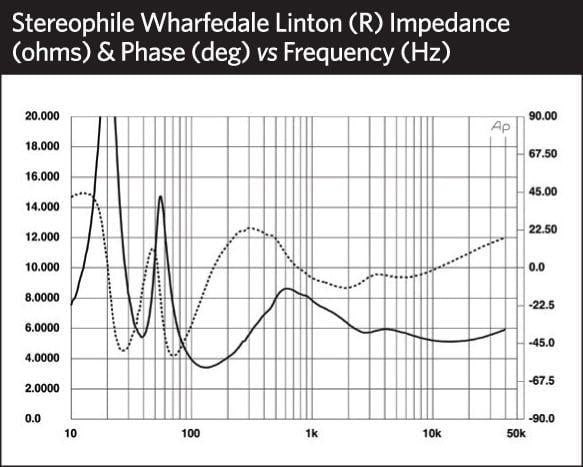
The impedance-magnitude plot has a saddle centered on 39Hz, which implies that this is the tuning frequency of the two flared ports on the Linton’s rear panel. The blue trace in Fig. 3 shows the woofer’s nearfield response, which has a minimum-motion notch at 41Hz. (This is the frequency at which the back pressure from the port resonance holds the cone stationary.) The nearfield response of the ports (red trace) peaks at the same frequency, and though its upper-frequency rolloff is disturbed by a broad peak around 200Hz, this is well down in level. The black trace below 300Hz in Fig. 3 shows the sum of the nearfield woofer and port outputs, taking into account the acoustic phase and the different distances of each radiator from a nominal far-field microphone position. The rise in response in the upper bass is due in part to the nearfield measurement technique. However, this graph does suggest that the port tuning is somewhat underdamped.
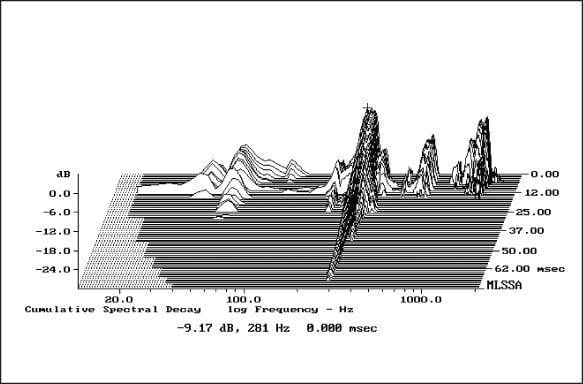
The Wharfedale’s far-field response averaged across a 30° horizontal window centered on the tweeter axis is shown as the black trace above 300Hz. It is superbly flat and even up to 15kHz, above which the tweeter’s output rapidly rolls off. This graph was taken with the grille in place. The response without the grille is very similar, but with the small suckout at the top of the midrange unit’s passband, it is slightly accentuated, and a small peak is introduced between 5 and 8kHz.
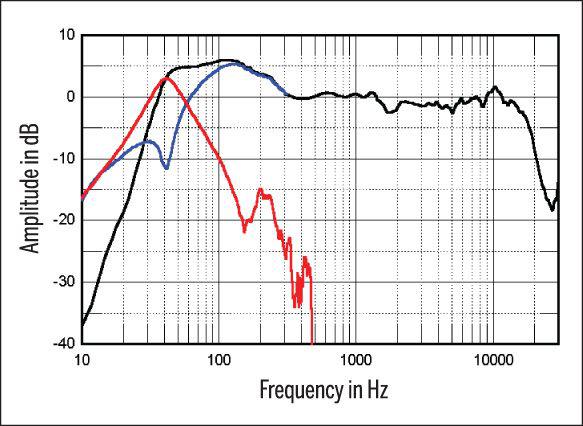
The Wharfedale’s tweeter is positioned slightly closer to one side of the baffle than the other. I plotted the horizontal dispersion with the behavior off-axis on the tweeter side to the front in Fig. 4. With the relatively wide baffle; it is not surprising that the Linton becomes increasingly directional above 8kHz. There is also a slight flare off-axis at the bottom of the tweeter’s passband, though this might be balanced in the room by the slightly dish-shaped on-axis response in the same region. In the vertical plane (fig.5), a suckout develops in the crossover region 10° below the tweeter axis, suggesting that the crossover and drive-unit polarities have been optimized for listening axes on and above the tweeter axis, which is around 36″ from the floor with the speakers sitting on their dedicated stands.
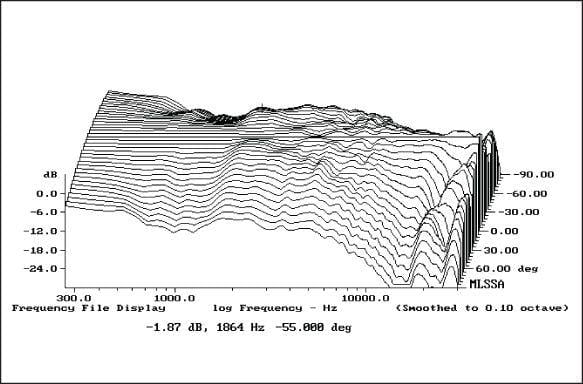
In the time domain, Linton’s step response (fig.6) indicates that the tweeter and midrange unit are connected in negative acoustic polarity and the woofer in positive polarity. (I checked this by looking at the nearfield step responses of the two lower-frequency units.) The decay of the tweeter’s step smoothly blends with the start of the midrange unit’s step, the decay of which smoothly blends with the start of the woofer’s step. This reinforces the optimal crossover implementation seen in Fig. 3. The Wharfedale’s cumulative spectral decay plot (fig.7), taken with the grille removed, is relatively clean overall, though some low-level delayed energy can be seen in the low and mid-treble regions. (As always with these plots, ignore the black ridge at exactly 15.75kHz, which is due to interference from the MLSSA host PC’s video circuitry.)
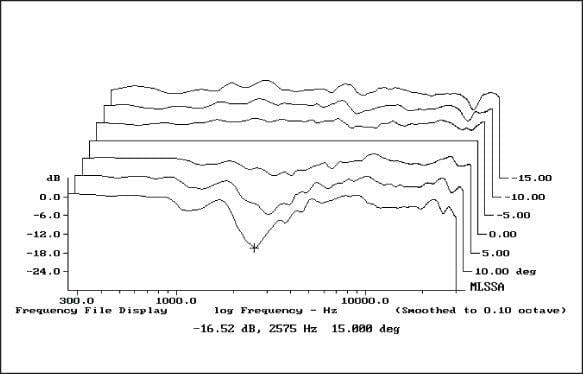
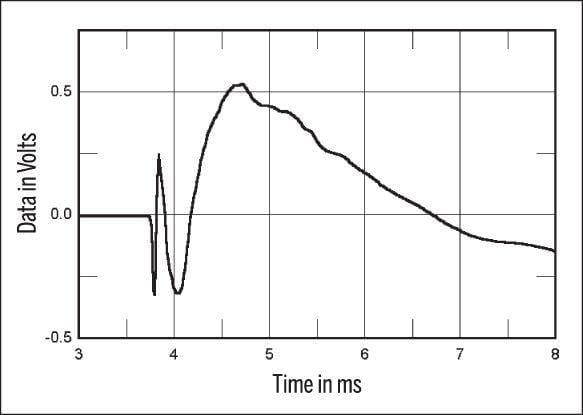
Overall, the Wharfedale Linton Heritage offers excellent measured performance, though that underdamped bass alignment might mean extra care having to be taken in room placement.—John Atkinson.
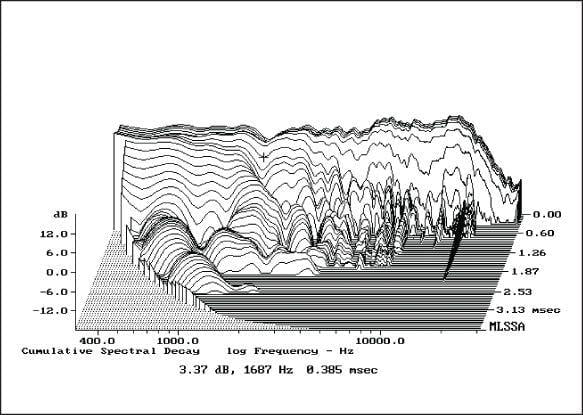












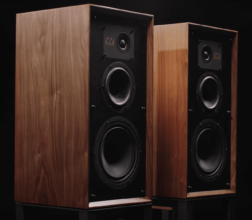
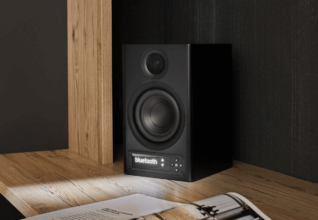
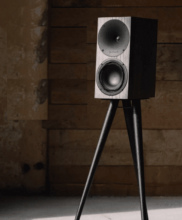

I don’t know how it sound but just the look makes me feel positive about them….a speaker that looks like a speaker and not like an ugly vacuum cleaner is already a good start!
At first with tube amp these speakers almost went back to the dealer. Waaaay to much bass, in fact not bass but BOOM! After over 120 hours the boom subsided on most tracks and the speakers became listenable. Took different positioning, away from walls and with about 2 inches of Styrofoam layered between the speakers & stands to control low bass (boom).
I’m playing adult rock & jazz via an OPPO digital source. Midrange is very up front on many tracks. The highs lack “air” and, as stated low bass notes can be very boomy. I’m hoping that after some more hours the woofers will loosening up some more.
Build quality is excellent. I ordered the Red Maple and they look great. Not too “red” but really nice. Stands are okay, I turned them around so the Wharfedale tag doesn’t show.
All in all at $1195.00 for the pair I’d say these are a good deal. ($1500.00 with stands) If used with an amp/pre-amp with a bass control potentiometer I’d guess there could be less boom. Wharfedale says that it’s all about speaker position and that may be true. But I’ve owned many different speakers & amp combos and never had such uncontrollable bass right out of the box. As stated, as the woofers loosened up this boom did subside. But I’m still not 100% happy with bass response.
Hi John;
I’ve also purchased a pair of Linton 85’s and I agree that bass is pretty strongly represented. An amp with a good damping factor and , more important, good phase margin helps quite a bit. Not a lot of tube amps meet these requirements and nor do the lesser gods among the transistor amps either.
My Marantz PM KI Pearl Lite has plenty of control over the speakers, warm midrange and refined treble; I’m happy wiht the combo.
Bass is still an issue, though; Control is okay but there’s too much of it in the room.
As an engineer and speaker freak I decided to do some measurements regarding the tuning of the reflex system:
Both ports closed:
Fc= 46Hz,
Both ports open:
Fb= 39Hz. (This system is tuned for maximum bass)
One port closed:
Fb= 27Hz (less bass but more extension)
In my room, using the it in lull length, the Linton 85’s sound best with one port closed. If the extra bass extension causes room resonances to get triggered, try the 85’s with both ports closed. With an Fc of 46Hz. there will still be plenty of extension left 😉
Kind regards;
Karsten
The Netherlands